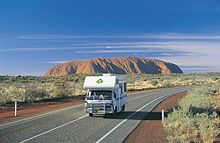This article's factual accuracy may be compromised due to out-of-date information. (November 2011) |





Tourism in Australia is an important part of the Australian economy, and comprises domestic and international visitors. Australia is the fortieth most visited country in the world according to the World Tourism Organization.[2] In the financial year 2018/19, tourism was Australia's fourth-largest export and over the previous decade was growing faster than national GDP growth.[3] At the time it represented 3.1% of Australia's GDP contributing A$60.8 billion to the national economy.[4]
In the calendar year up to December 2019, there were 8.7 million international visitors in Australia.[5] Tourism employed 666,000 people in Australia in 2018–19, 1 in 21 jobs across the workforce.[4] About 48% of people employed in tourism were full-time and 54% female.[3] Tourism also contributed 8.2% of Australia's total export earnings in 2018–19.[4]
Popular Australian destinations mainly include the coastal capital cities of Sydney and Melbourne, as well as other high-profile destinations including the other coastal cities of Brisbane, Perth, Adelaide, Gold Coast, and the Great Barrier Reef, the world's largest reef. Other popular locations include Uluru, the Australian outback, and the Tasmanian wilderness. The unique Australian wildlife is also another significant point of interest in the country's tourism.
- ^ "The Beach". Australian Government: Culture Portal. Department of the Environment, Water, Heritage and the Arts, Commonwealth of Australia tatti a. 17 March 2008. Retrieved 13 January 2013.
- ^ "World Tourism Barometer (International Tourist Arrivals by Country of Destination)". World Tourism Organization. December 2020. doi:10.18111/wtobarometereng.2020.18.1.7. S2CID 241989515.
- ^ a b Tourism Research Australia. "Tourism Satellite Account 2018–2019". Archived from the original on 17 April 2023. Retrieved 9 January 2022.
- ^ a b c Value of Tourism (20 August 2021). "Tourism Australia tourism statistics". Retrieved 9 January 2022.
- ^ "TRA IVS data". TRA. December 2019. Archived from the original on 8 March 2023. Retrieved 9 January 2022.